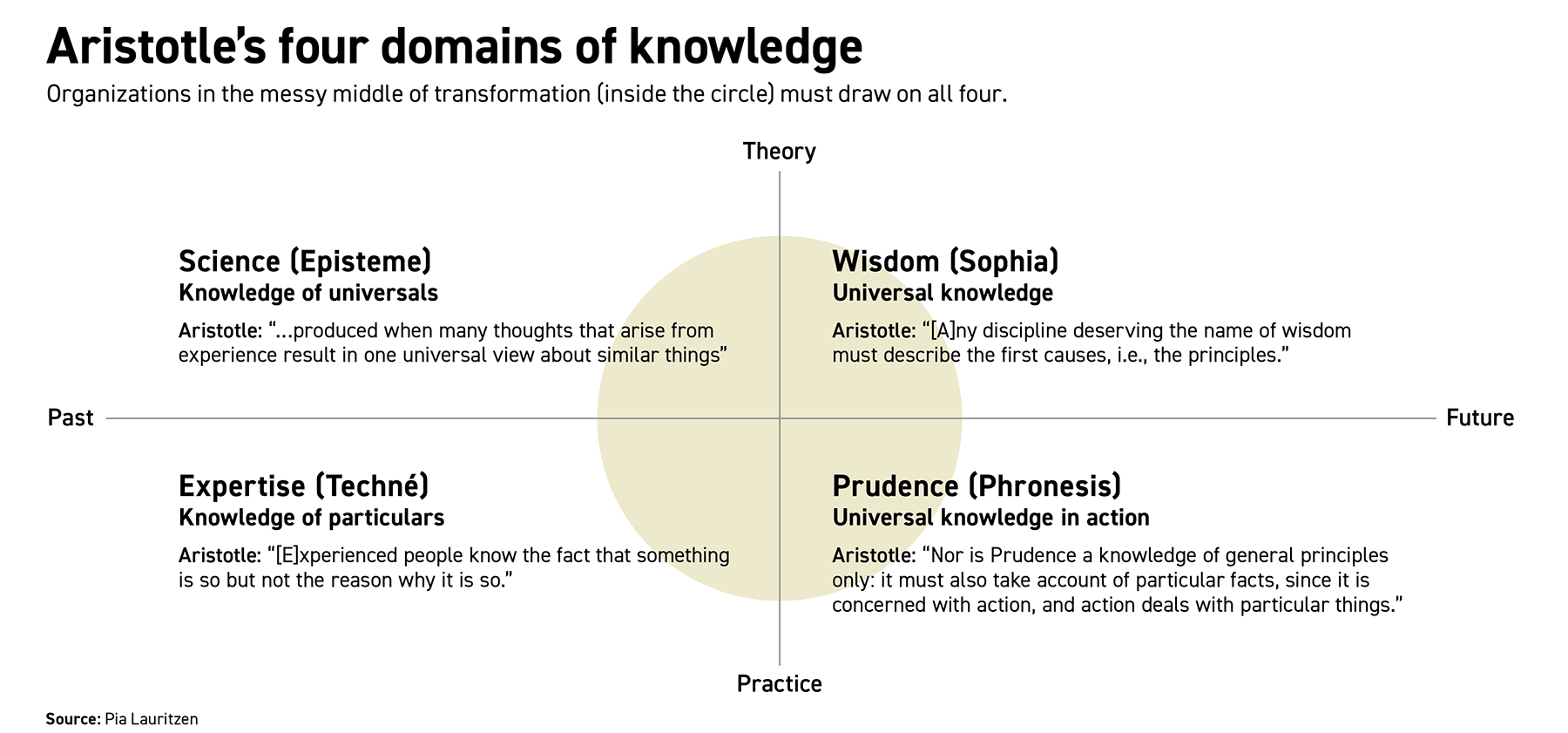A philosopher's guide to messy transformations
People need a shared understanding of what digital transformation means. Aristotle has a framework that helps.
What if the freshest insight on how to talk about 21st century transformations isn’t found in a snappy TEDx Talk or an MBA program but in the works of a philosopher born almost 2,500 years ago? I’ve always found the works of classical Greece indispensable to understanding the world today, including the world of business. Aristotle, for one, had a lot to say about knowledge that is not only relatable but useful for companies undergoing great change.
In my research and advisory work, I stress the importance of listening to the questions that people ask to understand not only what motivates them but also what they don’t get. I had a great opportunity recently to do this when I hosted a panel with 500 attendees discussing the challenges of digital transformation. These were people tasked with implementing change in large companies, but it was clear from their questions that they had very different understandings of what needed to be done. It occurred to me that Aristotle’s ideas about knowledge domains would help leaders translate these ways of thinking and talking about transformation into a shared language that would make the transformation more successful.
In Metaphysics (Book 1) and Nicomachean Ethics (Book 6), Aristotle made a distinction between expertise, science, wisdom, and prudence. That distinction can provide a simple framework for understanding what I call the messy middle of transformation. The messy middle is the unknown, uncertain space between past and future, between theory and practice, that characterizes organizations in the process of becoming something new. To navigate the messy middle of transformation, leaders must understand how the different knowledge domains contribute to the transformation—and help their employees find a way to be part of the same conversation.
Typically, when presented with four quadrants, the one you want to be in, or arrive at, is the upper right (so you’re indexing positively on both attributes). But, in this Aristotelian approach, you must resist the temptation to favor one quadrant over the others. Instead, you must engage and motivate those who are going to carry out the transformation by starting in the bottom left—the domain of expertise—and use this as a starting point to draw on knowledge from the other quadrants to drive the transformation forward.
Expertise
In the domain of expertise, people base their understanding of transformation on practical insight into the history and culture of the company. A question from an attendee on the panel I conducted illustrated this nicely: “How do you get an organization with a legacy of being extremely risk averse to embrace agility, which can be perceived as a more risky, trial-and-error approach?”
The question acknowledges and accepts that the company needs to embrace agility but demonstrates neither insight nor interest as to why it needs to do so. Whether the questioner trusts senior management’s decision to embrace agility, or she has other reasons for ignoring the “why,” it is obvious that she wants to know about the “how.” Too often leaders forget about the how. And that can be a costly mistake. If leaders assume they know what questions their employees need answered to drive the transformation forward rather than listen to what they actually ask, their initiatives will have little or no impact.
According to Eik Thyrsted Brandsgård, who was on the panel that day, culture is emergent, and it almost has a life of its own. Brandsgård leads the Group Business Agility at the LEGO Group, the toymaker that was founded in Billund, Denmark, in 1932 and now has 17,000 employees. “When you have an organization that has been organically growing over 90 years, then the culture is embedded in the language and the behaviors of the people working in the organization,” he said. The strength of legacy companies is that their culture is defined by conversations and behaviors that have been evolving for decades. “But the flip side is that the culture doesn’t always do what you want it to. It can resist an idea or just reject it,” he said.
It goes back to the why and how questions. If people are not interested in the why and lack information on the how, they will be resistant. Unless the message is aligned with how employees already think and talk about the transformation, they will ignore it or even try to undermine it.
Science
The important thing is that people agree on what problems to solve, not on how to talk about them. This is a reminder not to get too caught up in the theoretical frameworks leadership advisors and consultants use when they teach how to drive agile transformation.
In the domain of science, people ask questions that seek to elicit an understanding of why companies approach transformation the way they do. An example of such a question from the panel discussion was: “Agile methodologies were formed in the software development world and have eventually become a standard that companies and teams in almost any industry are driving towards. Why do you think it has had this proliferation, and do you think it makes sense?”
The person answering the question started out by saying, “I understand agile as a looser policy, while scrum and other specific methods may be more sector-specific.” There is an assumption here that the person asking the question has a theoretical knowledge of universal frameworks and methods and knows what terms like scrum, SAFe, and ART mean. However, the answer doesn’t show any insight into the practical circumstances in which transformation happens. Leaders who use consulting lingo when answering their employees’ questions risk sending a signal that they are more interested in discussing theoretical problems than they are in finding practical solutions.
To help people co-create a shared language, leaders must bridge the gap between the employees who know the theoretical frameworks and those who don’t. One way for leaders to do that is to adjust their communication to the people they are talking to. Another is to use words that everyone understands. For example, instead of referring to concepts like agile, leaders can talk about the importance of understanding and adjusting to customers’ changing needs.
Wisdom
The domain of wisdom is different from the other knowledge domains in that it draws on a completely different vocabulary. To find wisdom in something that is new to everyone, like digital transformation, leaders sometimes look for inspiration among thought leaders who are discovering new ways of thinking and talking about transformation rather than teaching existing theories. Typically, people representing the domain of wisdom use and combine terms from professional areas that are foreign to the organization. Consider, for example, regenerative leadership, an expression developed by sustainability expert Laura Storm. In her 2019 TEDx Talk, she described it this way: “I see the dawn of a new leadership logic, a new paradigm, a new generation of leaders. And their secret is that they apply the logic of life itself to how they run organizations.” The term was born in the world of environmentalism but has since gained currency well beyond it.
Leaders who use consulting lingo when answering employees’ questions risk sending a signal that they are more interested in theoretical problems than they are in practical solutions.
When I shared other examples of thought leaders using esoteric terms—like cynefin, teal organizations, and holacracy—in an early draft of this article, the editor suggested the words were too abstract. And that is exactly the point. People representing the domain of wisdom shed light on the basic principles of leadership and transformation, but the terms they use to describe them can be foreign to employees and are thus hard to translate into everyday actions.
This does not mean that leaders should not be inspired by abstract thinkers—if I believed that, I wouldn’t have introduced Aristotle. It just means they should be careful not to assume that it is as inspiring to their employees as it is to them.
Prudence
In the domain of prudence (good judgment), people depend on neither theoretical frameworks nor translation of basic principles to make sense of complexity. Instead, they use the inspiration they get from everyday practice, consultants, and thought leaders to talk about the transformation in a language everyone understands.
An example of this from the panel was an attendee observing, “In my experience the greatest threat against change is being busy. There is such a resistance against slack in our schedules and plans. Downtime is still considered ineffective. We invest so heavily in change, but we don't allow for time to learn. What is your take on this?” The question demonstrated insight into the basic principles of effective transformation without mentioning either theoretical concepts such as agile and scrum or foreign concepts such as cynefin and teal.
The question shows how insights from the domain of science and wisdom can shed light on a problem in the practical domain. This person asking the question is, in essence, a catalyst for change. The question provides a solution in itself. And leaders who are listening carefully will respond by giving people the time to learn and adjust. While internal and external catalysts play a vital role in translating between the different domains, the leader is responsible for driving the transformation forward by giving people what they need to change.
Transformations often fail because leaders don’t acknowledge the importance of inviting people with different ways of thinking and talking about transformation to join a common conversation. None of the four knowledge domains can exist without the others, and leaders depend on all of them to navigate the messy middle of transformation. As Aristotle would say, “All learning comes about from already existing knowledge.” Which is why leaders shouldn’t introduce and promote new frameworks when driving transformation. Instead, they must help their employees share their already existing knowledge and collaborate on turning it into new ways of working.
Author profile:
- Pia Lauritzen is an advisor to executives and cofounder of Qvest, a technology company that developed a platform for ensuring strategic alignment. A native of Denmark, Lauritzen has a Ph.D. in philosophy, has authored several books about leadership and questions, and is a regular columnist for Finans, Denmark’s largest business newspaper. Her 2019 TEDx talk is titled “What you don’t know about questions.”






